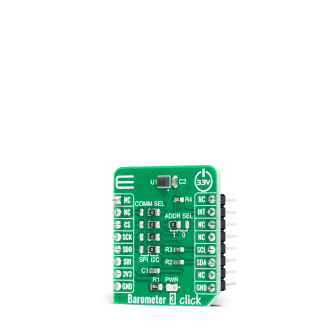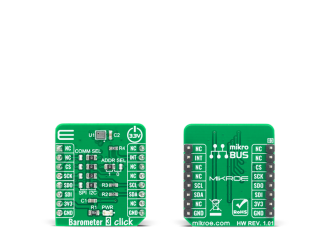
We strongly encourage users to use Package manager for sharing their code on Libstock website, because it boosts your efficiency and leaves the end user with no room for error. [more info]

Rating:
Author: MIKROE
Last Updated: 2020-08-07
Package Version: 1.0.0.0
mikroSDK Library: 1.0.0.0
Category: Pressure
Downloaded: 3471 times
Not followed.
License: MIT license
Barometer 3 Click is a compact add-on board for applications which require digital barometric air pressure measurement. This board features the DPS368, a digital barometric air pressure sensor from Infineon. It offers a high accuracy and a low current consumption, capable of measuring both pressure and temperature.
Do you want to subscribe in order to receive notifications regarding "Barometer 3 click" changes.
Do you want to unsubscribe in order to stop receiving notifications regarding "Barometer 3 click" changes.
Do you want to report abuse regarding "Barometer 3 click".


Library Description
The library covers all the necessary functions to control Barometer 3 click board. Library performs a standard SPI or I2C interface communication.
Key functions:
void barometer3_def_cfg ( void ) - Apply Default Configuration function.uint8_t barometer3_meas_temp_once ( float *result, uint8_t temp_osr ) - Get Temperature Measurement Once function.uint8_t barometer3_meas_prs_once ( float *result, uint8_t prs_osr ) - Get Pressure Measurement Once function.Examples description
The application is composed of three sections :
void application_task( )
{
status_val = barometer3_meas_prs_once( &pressure, BAROMETER3_PM_PRC_128 );
if ( status_val == BAROMETER3_SUCCESS )
{
mikrobus_logWrite( " Pressure: ", _LOG_TEXT );
FloatToStr( pressure, log_txt );
mikrobus_logWrite( log_txt, _LOG_TEXT );
mikrobus_logWrite( " Pa", _LOG_LINE );
mikrobus_logWrite( "-----------------------", _LOG_LINE );
Delay_ms( 1000 );
}
}
Other mikroE Libraries used in the example:
Additional notes and informations
Depending on the development board you are using, you may need USB UART click, USB UART 2 click or RS232 click to connect to your PC, for development systems with no UART to USB interface available on the board. The terminal available in all MikroElektronika compilers, or any other terminal application of your choice, can be used to read the message.